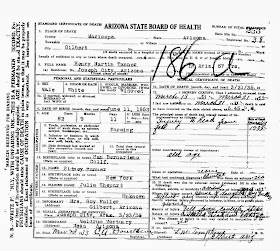It is not promoted as a genealogy tool; however, it seems to me that anyone having any residential location in the United States, could clearly benefit, by obtaining a home history; relatives and occupants. The Died in House service is the first of its kind; it provides users with death records associated to a specific address. This seems to have tremendous potential, for the genealogy and family history community, especially for close knit neighborhoods, considering data obtained from obituary notices and death certificates.Subsequently, Tony Proctor made the following comment about the UK:
I'd like to suggest a generalisation of this topic James. There is a homes-based collaborative site in UK too called MyHomesPast.Tony also explains his thoughts about the program in another Google+ post:
MyHomesPast is a collaborative site allowing people to create a pictorial history of the homes they've lived in, including details of former residents and timelines for the properties. This is one of the forms of local history that I mentioned as falling outside of traditional genealogy but having a strong overlap with it - hence my use of the preferred term micro-history. The site was only launched in 2012 and so has a few teething troubles, such as requiring a mandatory postal code. This automatically eliminates many of the properties that were demolished during the slum clearance projects of the 1960-70's in England, and leaves people like myself unable to use it. Still, this is the way things are going and I hope the site succeeds.
This is an interesting avenue of research, but here in Arizona there are some strange obstacles to this type of endeavor. It is currently impermissible for real estate sales people to mention that anyone died in a house to a potential purchaser. In Arizona you are not required to disclose if your home has been the site of a natural death, suicide, homicide or any other crime classified as a felony. So even if the above websites became viable options, where are they going to get their basic information?
I have been heavily involved in Arizona real estate law and actually had a real estate license for a while and I cannot think of anyway I could find out whether or not someone had died in a house here in Arizona other than by chance. Here is a copy of my Great-grandfather's death certificate. He fell and was injured at his daughter's house in Gilbert, Maricopa, Arizona on 13 March 1935 and died on 21 March 1935. Look carefully and see if you can find the address or the location of where he died?
Guess what? There is nothing on this death certificate giving the address of either the site of the accident or the place where he died. Of course, this may be entirely different in states other than Arizona, but I am sure that the home occupied by his daughter in 1935 is very likely still being used. Did he die at home or in a hospital? By the way the death certificate says "If death occurred in a hospital or institution give its NAME instead of street number." Neither of these is present on this death certificate.
Just a thought.


I understand there was no hospital in Gilbert, AZ in 1935 .... another clue?
ReplyDeleteThat is likely true. But I do not know where he went during the time between the accident and his death.
DeleteThere are lots of rural areas in the US where there are no street addresses. A mailing address of RFD 2, Box 30 is not easy to pinpoint, and even during the recent period of time in which death *certificates* have been made with spaces demanding addresses, seeing something like "RD3" is pretty common.
ReplyDeleteYes, ownership histories can be established via tax parcels in many areas, but these would take a lot of research and very good maps to correlate with death records where only a Magisterial District or Township was given as a place of death.
So this approach can work in many cities and towns, but not necessarily elsewhere without a lot of work. In cities with large apartment buildings, establishing an exact death location could also be difficult.
Very good points. We have a lot of difficulty sometimes finding a death date and place, without identifying the house where it occurred.
DeleteAs a point of interest, the 1940 census, (as I'm sure you know), does give residency for individuals in 1935. Therefore, if his daughter or other relative, is still residing in the same home in 1940, it should be the same address for 1935. Thus census records, with little effort, do offer a point of investigative evaluation, on a nationwide basis. In fact, developing a program to index the 1940 census and other similar type records, from a standpoint of address locality, might be very fruitful.
ReplyDeletehttp://newsgroups.derkeiler.com/pdf/Archive/Soc/soc.genealogy.britain/2005-11/msg01019.pdf
Many brick wall problems might be resolved, as well as help those working on finding related families from a common ancestor; also, those compiling histories, etc., would find this kind of index key to be most productive, as suggested by the complex process used for the City of Chicago.
http://webapps.cityofchicago.org/landmarksweb/static/pdf/Your_House_Has_A_History.pdf